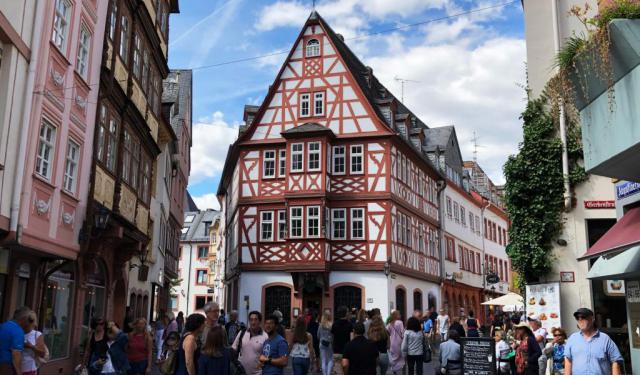
St. Peter Church, Mainz
Saint Peter's Church (Peterskirche) in Mainz stands as one of the city's most important Rococo structures, located beneath Deutschhaus in the northwest of Mainz's historical center. Originally a collegiate monastery known as "Saint Peter before the walls" and dating back to the 10th century, it was dedicated to the apostle Peter. Today, it serves as a parish church for Saint Peter.
The current baroque structure, a three-bay hall with a double onion dome tower, was designed by architect Johann Valentin Thoman and completed in 1762. Over the years, the church witnessed significant historical changes. During the French occupation in 1813, the building was turned into a stable. Later, under the Prussian garrison’s control from 1816 to 1918, it became a garrison church.
Saint Peter’s endured significant damage during World War II, surviving an initial air raid in 1942 but suffering severe destruction in subsequent attacks. In February 1945, the church’s tower façade was lost, and the nave burned out. Temporary repairs allowed the community to use it by 1952, and a full restoration was completed in 1961, including the reconstruction of the iconic twin towers.
Despite the heavy damage, some elements, like the grand baroque altars, stucco decoration, and Johannes Förster’s remarkable pulpit, survived. However, the original organ, ceiling frescoes by Joseph Ignaz Appiani from 1755, and choir stalls were lost. During its post-war restoration (1973–1989), new ceiling frescoes were created by Karl Manninger, based on old photographs.
A modern altar by Gernot Rumpf was added, symbolizing Saint Peter as the "fisher of men," featuring a playful representation of fish turning into people. This altar, along with the ambo and Paschal candle, adds a contemporary touch to the church’s storied past. A bronze statue of Father Franz Adam Landvogt, a former pastor, was placed in the crypt in 2003 to commemorate the 50th anniversary of his passing.
The current baroque structure, a three-bay hall with a double onion dome tower, was designed by architect Johann Valentin Thoman and completed in 1762. Over the years, the church witnessed significant historical changes. During the French occupation in 1813, the building was turned into a stable. Later, under the Prussian garrison’s control from 1816 to 1918, it became a garrison church.
Saint Peter’s endured significant damage during World War II, surviving an initial air raid in 1942 but suffering severe destruction in subsequent attacks. In February 1945, the church’s tower façade was lost, and the nave burned out. Temporary repairs allowed the community to use it by 1952, and a full restoration was completed in 1961, including the reconstruction of the iconic twin towers.
Despite the heavy damage, some elements, like the grand baroque altars, stucco decoration, and Johannes Förster’s remarkable pulpit, survived. However, the original organ, ceiling frescoes by Joseph Ignaz Appiani from 1755, and choir stalls were lost. During its post-war restoration (1973–1989), new ceiling frescoes were created by Karl Manninger, based on old photographs.
A modern altar by Gernot Rumpf was added, symbolizing Saint Peter as the "fisher of men," featuring a playful representation of fish turning into people. This altar, along with the ambo and Paschal candle, adds a contemporary touch to the church’s storied past. A bronze statue of Father Franz Adam Landvogt, a former pastor, was placed in the crypt in 2003 to commemorate the 50th anniversary of his passing.
Want to visit this sight? Check out these Self-Guided Walking Tours in Mainz. Alternatively, you can download the mobile app "GPSmyCity: Walks in 1K+ Cities" from Apple App Store or Google Play Store. The app turns your mobile device to a personal tour guide and it works offline, so no data plan is needed when traveling abroad.
St. Peter Church on Map






Sight Name: St. Peter Church
Sight Location: Mainz, Germany (See walking tours in Mainz)
Sight Type: Religious
Sight Location: Mainz, Germany (See walking tours in Mainz)
Sight Type: Religious
Walking Tours in Mainz, Germany
Create Your Own Walk in Mainz
Creating your own self-guided walk in Mainz is easy and fun. Choose the city attractions that you want to see and a walk route map will be created just for you. You can even set your hotel as the start point of the walk.
In the Footsteps of Gutenberg
The capital of Rhineland-Palatinate, Mainz has made a name throughout the world as Gutenberg's city, the birthplace of Johannes Gutenberg and his great invention, the first movable metal-type printing press. It is precisely for this important heritage that Mainz has retained its importance as a hub for some of Germany's oldest publishing houses.
Following in the footsteps of Gutenberg... view more
Tour Duration: 1 Hour(s)
Travel Distance: 1.2 Km or 0.7 Miles
Following in the footsteps of Gutenberg... view more
Tour Duration: 1 Hour(s)
Travel Distance: 1.2 Km or 0.7 Miles
Mainz Introduction Walking Tour
Mainz is the Rhineland-Palatinate state capital and its largest city. It is located on the Rhine river, where the Main river joins the Rhine. Mainz has remained a prosperous city and is an important container port hub.
Mainz was founded as a Roman military fortress in the 1st century BC. The Roman stronghold was called Mogontiacum. Visitors can see several Roman shipwrecks and learn more about... view more
Tour Duration: 2 Hour(s)
Travel Distance: 3.3 Km or 2.1 Miles
Mainz was founded as a Roman military fortress in the 1st century BC. The Roman stronghold was called Mogontiacum. Visitors can see several Roman shipwrecks and learn more about... view more
Tour Duration: 2 Hour(s)
Travel Distance: 3.3 Km or 2.1 Miles


